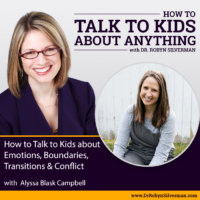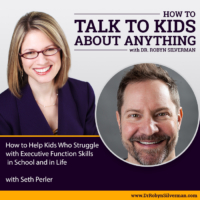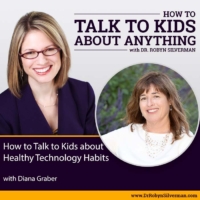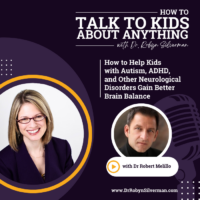Podcast: Play in new window | Download
Subscribe: Apple Podcasts | RSS | More
How to Help your Kids Process Big Emotions
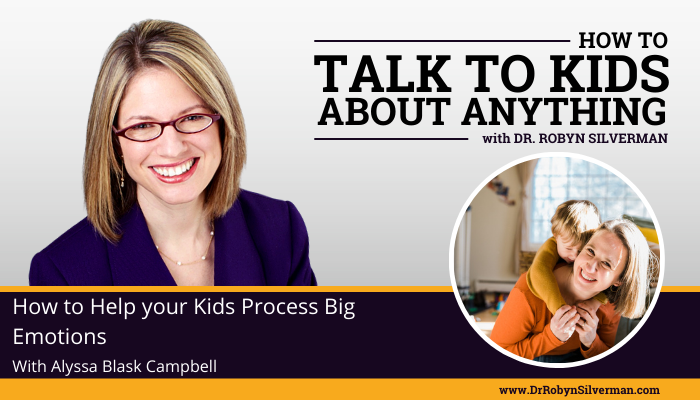
Let us navigate the challenging world of tantrums in children. In today’s podcast, Dr. Robyn together with Alyssa Blask Campbell will provide practical tips, real-life stories, and expert insights to empower you as a parent. Join them as they explore effective strategies for understanding and managing tantrums, fostering emotional growth, and strengthening the parent-child bond. Get ready to gain valuable tools for creating a harmonious home environment and transform tantrums into teachable moments, one episode at a time.
Guest Expert: Alyssa Blask Campbell
What to do when your child throws a tantrum? How to react when your child hits, punches, or bites? How do we help to co-regulate our child’s nervous system? And how do we head-off tantrums before they happen? As you know, we’ve entered a new way of helping our children through big emotions—moving far away from the ways our parents used to parent us and their parents used to parent our parents. Instead of pushing big feelings under the rug, hiding them in the closet or stuffing them down into our bodies like a batch of old brownies, as our understanding of developing brains has increased, today’s parents are looking for a new way to help their children understand their feelings and learn to process them. Who is leading the way for us today? Alyssa Blask Campbell is joining us for her second time today.
Bio:
Alyssa is the founder & CEO of Seed & Sew, an organization committed to giving parents, teachers, and caregivers the tools to raise emotionally intelligent humans. Seed & Sew offers a one-of-a-kind certification program for childcare centers and home-based providers through the Schools Excelling in Emotional Development (S.E.E.D.) Certification. An emotional development expert with a master’s degree in early education, Alyssa co-created the Collaborative Emotion Processing (CEP) method, which is unique in how it equips adults to be mindful of their own emotional intelligence so they can show up for the kids in their lives in a productive way. As an early childhood educator and parent, Seed & Sew provides the tools that Alyssa needed but never had: an in-person and online community where parents and educators can find the support they need to do the work for themselves and with tiny humans. You can find more information at SeedandSew.org. And guess what? Alyssa is my book-birthday twin. We both have books coming out into the world on October 10th of this year! And both of our books are available for pre-order right now. As you know, my book is called How to Talk to Kids about Anything and is available for presale wherever books are sold—and Alyssa’s book is called Tiny Humans, Big Emotions and is also available for pre-purchase wherever books are sold!
Oh- and something pretty exciting! Alyssa and I are going to be doing something special together to celebrate our book-birthday twinning! We are having a special
Important message:
- Notice: If you’re going to be a detective for what’s really driving the behavior, you got to start by observing and just noticing.
- Phase 1: Allowing. He’s allowed to not like either of the choices. I’m allowing him to feel disappointed. I’m not going, “Oh buddy, we talked about this.”
- Phase 2: Recognizing. Recognizing his emotion and what he’s experiencing.
- Phase 3: Security. This is where we let him know in different ways that this feeling will pass and he won’t always feel this way. This is where we see a game changer with kids who are struggling with anxiety. In here I’ll say something like, “Oh, I wonder what we could do when you’re ready to feel calm again.” which signals to the brain, “Oh right, calm exists. I’m not going to feel like this forever.”
- Phase 4: Coping. Coping is specific to each individual. This is huge and is something that I think is often left off the table. What helps me calm is actually different than what helps him calm.
- Phase 5: Problem solving. Sometimes, we’re not doing it at the end of the night or right before a nap because they are often dysregulated ’cause they’re getting tired.
- Interceptive is noticing what’s happening inside. So if I say I have butterflies in my stomach, you know what that feels like, hungry, tired, et cetera, noticing those ceilings inside vestibular is moving that plane of your head.
- Proprioceptive is that big muscle input. So big jumps or when kids are climbing on things, et cetera.
- We are all seeking certain things. There are certain things that help us regulate and we’re sensitive to certain things.
- We are all born with unique sensory systems. And then we looked at like, “Oh. What helps him feel calm? What helps him regulate?” Now when we know these things about ourselves, it’s our job as the adult to be mindful of our regulation so that we can show up in the way that’s best supportive for the child. It’s not their job to adjust for us.
- I’ve never left the day as a parent or a teacher and been like, “Wow, I was perfect today.” Not the goal. So when they are out of control, instead of putting them in a timeout, because a timeout actually doesn’t solve the problem, it just temporarily says; “I want you to feel bad about this behavior so that hopefully you don’t do it again.” It’s so much more powerful to find the right thing to say.
- When your child is be being defiant, it’s best not to yell at him for doing the wrong thing, but instead we want to first recognize they are not in control of their words and their actions despite how it looks.
- They have self-awareness. They can notice what’s happening in their body as it is building. And they have self-regulation. They can notice and say, “I’m going to calm my body.” If they have those two skills mastered, then they have access to self-control. If they don’t have those two skills mastered, they are not accessing their prefrontal cortex in the moment, which is your rational thinking brain and so they do not have access to self-control. They’re not choosing their words or their actions. They’re acting from a place of dysregulation.
- The number one thing I would like folks to do is to learn about their sensory systems and the child in front of them, because that is where we’re going to learn. There isn’t a one size fits all response to kids.
Notable quotes:
- “What helps me calm is actually different than what helps him calm.”
- “We are all seeking certain things. There are certain things that help us regulate and we’re sensitive to certain things.”
- “We are all born with unique sensory systems.”
- “It’s our job as the adult to be mindful of our regulation so that we can show up in the way that’s best supportive for the child. It’s not their job to adjust for us.”
- “A timeout actually doesn’t solve the problem, it just temporarily says; “I want you to feel bad about this behavior so that hopefully you don’t do it again.” It’s so much more powerful to find the right thing to say.”
- “There isn’t a one size fits all response to kids.”
Resources:
- Books: Tiny Humans Big Emotion: https://www.seedandsew.org/book
- Podcast: Voices of Your Village
- Instagram: https://www.instagram.com/seed.and.sew/
- Facebook: https://www.facebook.com/seedandsew.org

